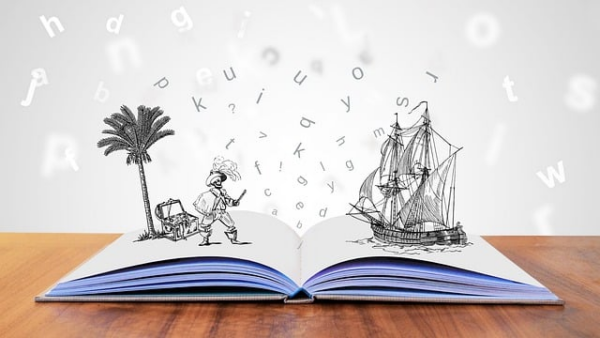Writing a multi-POV novel is like orchestrating a symphony where each instrument has its own melody, yet they all harmonize to tell a single, epic story. Every character brings a fresh perspective, shaping the story’s narrative like individual brushstrokes on a grand canvas. This writing style is particularly powerful in genres like epic fantasy and historical fiction, where layered plots and complex character arcs build tension, suspense, and intrigue.
A prime example of this technique is George R.R. Martin’s Ice and Fire series, in which multiple perspectives enhance narrative complexity and character depth.
In this article, we’ll dive into the “how” and “why” of managing multiple POVs, exploring techniques seasoned authors use to keep their voices distinct and storylines seamlessly woven together. Why bother with all this complexity? Simply put, readers love it. Studies show that 63% of readers feel more emotionally engaged with stories that explore multiple perspectives, adding richness to the narrative landscape (Reader Analytics, 2022). This engagement translates to one of the biggest draws in publishing: reader loyalty.
Why Write a Multi-POV Novel? The Power of Multiple Viewpoints
Choosing a multi-POV structure is like offering your readers a 360-degree tour of your story’s universe. Think of each character’s voice as a lens through which we see the world—unique and sometimes contradictory. By switching between characters, you’re creating a narrative that’s more than just one story; it’s a mosaic of interconnected lives, thoughts, and motivations.
Using multiple points of view allows you to showcase various narratives rather than just one woman’s story, emphasizing the diversity of experiences and perspectives.
This method isn’t just popular—it’s proven. Bestsellers like A Song of Ice and Fire use multiple perspectives to craft a web of intrigue and drama, each chapter dropping readers into different minds, each with its own secrets and conflicts. It’s a method that makes characters’ alliances, rivalries, and emotions all the more real. And it’s not just about genre fiction; from thrillers to romance, multiple POVs give readers the sense that they’re piecing together a mystery with each page. In a market saturated with single-narrative novels, this layered approach can make your book stand out.
Insight from the Industry: Spines’ advanced platform tools allow authors to plan, organize, and even experiment with multiple perspectives seamlessly. The advanced technology used on the platform helps writers create dynamic character shifts and refine distinct voices, giving you room to be creative without losing narrative clarity.
Crafting Distinct Voices for Each Character: Avoiding the “Head Hop”
Writing multiple POVs means avoiding the jarring “head hop,” where readers lose track of who’s speaking or thinking. Every POV character should have a voice as unique as a fingerprint. Main POV characters are essential for delivering a compelling narrative experience, as they serve as the lens through which readers engage with the story. Here’s where we trade broad strokes for fine details: work with different cadences, vocabularies, and sentence structures. Think of a young duke, formal and deliberate, whose voice contrasts with his streetwise valet’s sharp, quick-witted observations.
Crafting unique voices takes more than surface-level tweaks. Dive into each character’s worldview. What do they notice? What emotions and insights define their perspective? Perhaps one character is poetic and contemplative, while another is factual and blunt. Successful multi-POV novels give each character a different frame, letting readers pick up on these cues without being told. Consistency is key, so keep a profile for each character’s mannerisms, speech patterns, and mindset. This way, you’re not just showing different perspectives; you’re creating a tapestry of personalities.
Pro Tip: Spines’ editing tools can help you identify inconsistent tones or overlapping language patterns, flagging any sections where your characters’ voices may start to blend. By refining these shifts, you’ll keep readers invested and engaged, scene by scene.
Choosing the Right POV Style: First, Third, or Omniscient?
Multi-POV novels are all about choosing the right tool for the job. Think of your POV style as the lens you’ll be using to frame each character’s world. Here’s a breakdown:
– First-Person: When readers are in a character’s head, they see the world through their eyes, thoughts, and biases. First-person creates a deep emotional bond but can become tricky with multiple voices—each must be undeniably distinct.
– Third-Person Limited: The “over-the-shoulder” view. This style lets you dive into each character’s thoughts but with a touch of distance. It’s perfect for building suspense since readers only know what the character knows.
– Omniscient: The all-seeing, god-like narrator. Ideal for epics with sprawling worlds and countless characters, this style lets readers see every angle. But beware—too much omniscience can dilute the personal connection readers feel with each character.
When deciding on a POV, consider your genre, themes, and how closely you want readers to bond with each character. A thriller might benefit from first-person POVs that increase the story’s intensity, while an epic fantasy might need third-person or omniscient for its grand scope.
> Did You Know? Spines’ platform makes it easy to experiment with different POV styles, letting you preview how each shift changes the tone and pacing. You can easily adjust POVs within your manuscript to find the structure that best fits your story.
Introducing Multiple Characters without Overwhelming Readers
If writing a multi-POV novel is a dance, then introducing characters is like opening the ballroom doors. Don’t overwhelm readers with a dozen characters in the first chapter. Instead, introduce them gradually, giving each their own “entrance” moment that lets readers get to know them. When using multiple POV characters, ensure each character contributes uniquely to the narrative, adding distinct voices and perspectives to maintain reader engagement.
A powerful technique is to start with a central character and gradually expand as if zooming out to reveal the bigger picture. Consider each character’s introduction like a puzzle piece. If you introduce them well, readers can follow the story without feeling lost. And each character’s appearance should add a fresh angle, whether it’s revealing a hidden conflict, a fresh insight, or a new perspective.
At Spines, we offer tools that help authors structure their manuscripts for clarity, guiding you on when to introduce each character. With our intuitive platform, you can map out each entrance to ensure readers are drawn in, not thrown off.
Planning POV Shifts: Timing Matters
In multi-POV novels, timing is your best friend. Each POV shift should feel like an intentional beat in your story’s rhythm, not an abrupt note. Plan transitions carefully, asking yourself if each switch brings new information or a fresh angle. Well-placed POV shifts can add suspense, help reveal plot twists, and layer emotional depth.
Managing multiple points of view can be complex and significantly impact the pacing of your story.
To prevent disjointed pacing, you can signal POV changes with scene breaks, headers, or chapter shifts. Avoid rapid “ping-pong” shifts between characters in a single scene, as this can quickly tire readers. Instead, treat each perspective as a chance to add layers. Consider breaking scenes into smaller, digestible moments and switching only when it serves the story’s tension or intrigue.
Pro Tip: Spines’ tools let you organize chapters by POV, making it easy to plan and visualize the pacing of your story. This helps you determine where to shift perspectives for maximum impact, keeping the narrative flow engaging and smooth.
Your Publishing Journey Awaits – Start NowWriting Multiple POVs in the Same Scene: Adding Layers without Losing Readers
Writing a scene with multiple POVs is like filming from multiple camera angles—each one captures a slightly different emotion, perspective, or detail. When done well, it’s like watching a scene in HD, with added depth and tension. Done poorly, it feels like a shaky cam at a concert.
For example, in a tense argument between two characters, try alternating brief perspectives to show how each interprets the exchange. Perhaps one is fuming with anger, while the other is confused or feeling guilty. These back-and-forths can create suspense as readers wonder who’s right, who’s hiding something, or how each character will react.
With Spines, you can experiment with this technique, using our tools to ensure each perspective flows naturally. Our technology helps you organize and fine-tune these shifts, keeping clarity and tension intact.
Avoiding Pitfalls: Common Multi-POV Mistakes
Multi-POV novels are challenging but rewarding if done right. One common mistake is letting certain POVs outshine others. Every POV should bring something unique to the story. Otherwise, readers might lose interest in certain characters—or worse, skip their chapters altogether. Keep each character’s journey relevant by defining their goals and conflicts clearly.
Writing multi-POV books comes with its own set of challenges and benefits. It is crucial to have clear character voices and maintain emotional connections to avoid reader confusion and enhance storytelling.
Another pitfall is repetitive storytelling. If two characters recount the same events, readers may feel as if they’re re-reading the same chapter. To avoid this, ensure each POV introduces new elements to the narrative. Use each character’s unique perspective to add fresh insights, whether that’s hidden motivations, secrets, or emotional responses.
Spines’ editing tools make it easier to identify these issues early on. Our platform helps you review how each character contributes, ensuring all POVs are necessary and engaging.
Multi-POV Done Right: Learn from the Greats
From The Night Circus to The Poisonwood Bible, multi-POV novels are more than just bestsellers; they’re masterclasses in character dynamics. These books show us that when handled with care, multiple perspectives can create a narrative that’s rich, immersive, and unforgettable.
However, the challenges and intricacies involved in connecting with a single main character versus multiple main characters are significant. Authors must navigate the potential pitfalls of reader engagement with various character arcs while maintaining the protagonist’s integrity amidst multiple perspectives.
Take note of how each author shifts perspectives, builds tension, and lets each character’s voice shine. A well-crafted multi-POV story reads like a journey through a kaleidoscope, with each new viewpoint adding clarity to the whole.
Embracing the Multi-POV Journey
Writing a multi-POV novel is like hosting a dinner party where every guest has a story worth hearing. It’s complex, exhilarating, and, ultimately, incredibly rewarding. You’re giving readers the chance to explore a world from every angle, with every character’s voice adding a unique color.
Using multiple POVs allows you to delve into different character perspectives, enhancing storytelling by offering varied insights and emotional depth.
If you’re ready to bring your multi-POV story to life, Spines is here to help every step of the way. With tools designed for seamless POV management, dynamic character shifts, and fine-tuning distinct voices, we’re here to make your writing process smoother. Start experimenting with multiple perspectives today and give your readers an immersive, multi-dimensional experience. Ready to get started? Let Spines support your creative journey.
FAQs – How to Write a Multi-POV Novel
Why should I write a novel with multiple POVs?
Writing a multi-POV novel allows you to create a richer, more immersive narrative by exploring different characters’ thoughts, feelings, and motivations. It helps build suspense and intrigue, since readers get to see different sides of conflicts and secrets unfold. Additionally, this approach fosters stronger emotional engagement and loyalty because readers connect with multiple characters, making your story feel more dynamic and nuanced.
How do I create distinct voices for each character?
To craft distinct voices, focus on each character’s personality, background, and worldview. Think about how they speak, what words they choose, their tone, and their emotional reactions. For example, a noble character might use formal, deliberate language, while a street-smart character could have a faster, sharper style. Consistency is key, so keep notes on each character’s speech patterns and mindset to ensure they remain recognizable throughout your novel.
What POV styles work best for multi-POV novels?
The three most common POV styles are first-person, third-person limited, and omniscient. First-person POV gives deep emotional connection but requires very distinct voices to avoid confusion. Third-person limited offers a balance, giving insight into characters’ thoughts while maintaining narrative distance, great for building suspense. Omniscient POV is useful for epic tales with many characters but can reduce intimacy if overused. The best choice depends on your story’s genre and how close you want readers to feel to each character.
Are multi-POV novels popular with readers?
Yes, multi-POV novels are highly popular because they provide a more immersive reading experience. Studies show that over 60% of readers feel more emotionally connected to stories that explore multiple viewpoints, as this approach offers deeper insights into characters’ motives and conflicts. This emotional engagement often leads to higher reader loyalty and makes multi-POV novels stand out in a crowded market.
Can multiple POVs appear in the same scene?
Yes, multiple POVs can be used within the same scene to show different characters’ reactions or thoughts about shared events. This technique can deepen tension and add complexity, like showing an argument from both participants’ points of view. However, it’s important to keep these shifts clear and brief so readers don’t get lost or overwhelmed by too many quick perspective changes.








